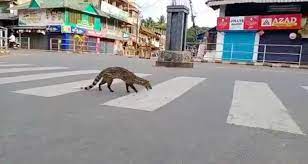During these days of lockdown across various parts of India, we see reports of ‘wild’ animals coming over to the cities, towns and urban clusters. In Uttarakhand, an elephant was reported to come down unusually near Hari ki Pauri in Haridwar. A leopard was sighted in Almora. In Karnataka, elephants, spotted deer and sambar deer had transgressed into towns, while in Maharashtra, people spotted scores of civet cats, mongooses and porcupines in communities. All these ‘trespasses’ have been happening not only in India but across the world, wherever lockdowns took place and regular human activities have been curtailed. Once these lockdowns are lifted, animals are expected to retire back to their wild environment – wherever and however limited they are.
To get a perspective of this, note that of the total land area of the world, which is about 510 million square km, 30% is desert and 24% mountainous, leaving us humans to occupy about 45-50% of the remaining area when we started to live as communities about 17,000 years ago. (Prior to that, humans lived in the wild, along with animals and plants, as hunter gatherers). And over these millennia, particularly during the present one, we have built cities and urban clusters, thus making what was ‘wild’ land into ‘civilised’ land. (Note, too, that even today, adivasis and tribals still live in the wild, along with the local animals and plants). Indeed, geo-zoologists have argued that it is we humans who have transgressed and changed the landscape of Mother Earth.
Incidentally, this appears to be true of not only on land, but in water as well. BBC news reported how with a lull in traffic in the Bosphorus marine route during lockdown in Istanbul, dolphins are increasingly sighted near the shores of the city. Likewise, as the Ganga became less polluted in recent days due to decreased industrial and human waste during lockdown, the Ganges dolphins and gharials (fish-eating crocodiles) have been sighted in larger numbers. In mountains, too; Marco Lambertini of the World Wildlife Fund is concerned that COVID-19 could infect mountain gorillas which are likely to be particularly vulnerable as they share about 98% of their DNA with humans. They, like all great apes, are already endangered due to habitat loss, poaching and diseases – only 900 remain in the mountains of Central Africa.
Source with edits and revisions: Editorials, The Hindu
Questions
1. What is the main point of the passage?
a. Humans have transgressed the landscape of Earth.
b. Animals are first time coming out in the urban area due to the lockdown.
c. Mountain Gorrilla are most vulnerable to corona virus.
d. None of the above.
2. Which of the following can’t be inferred from the passage?
a. Protecting mountain gorillas from getting infected from covid is a huge concern
b. We humans have occupied more than fourty percent of the land
c. Ghariyals have been sighted in Ganges for the first time ever.
d. The animals are less hesitant to visit humans land during the lockdown.
3. The statement geo-zoologists have argued that it is we humans who have transgressed and changed the landscape of Mother Earth plays which of the following roles in the argument?
a. It acts as a premise for the argument.
b. It acts as a conclusion of the argument
c. It is an inference drawn by the author
d. None of the above.
4. Which of the following explains the concern of Marco Lambertini?
a. The large scale poaching of apes
b. The similarity between the DNAs of Mountain gorilla and humans.
c. Corona virus infection in Mountain gorillas.
d. The trespassing of humans in mountain gorilla’s habitat
5. What role is played by the author’s description of an elephant that was reported to come down unusually near Hari ki Pauri in Haridwar, in relation to the conclusion?
a. It supports the conclusion by providing an example.
b. It supports the conclusion by providing a contradictory example.
c. It weakens the conclusion by providing an example.
d. It is unrelated to the conclusion.

Answers
1. D
2. C
3. C
4. C
5. A

